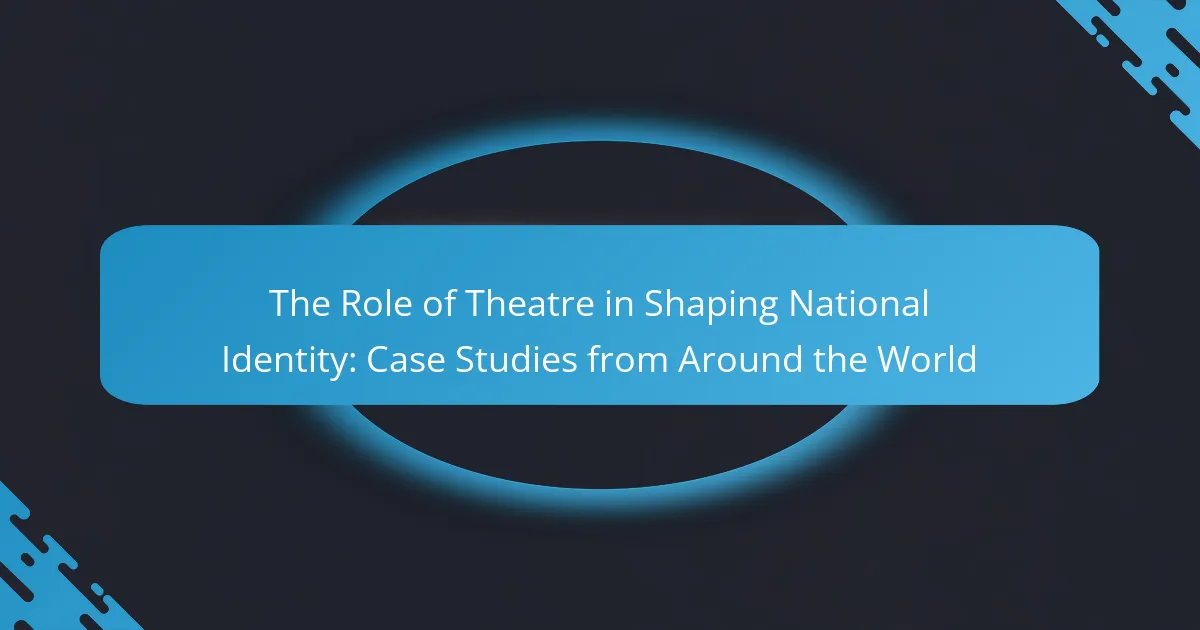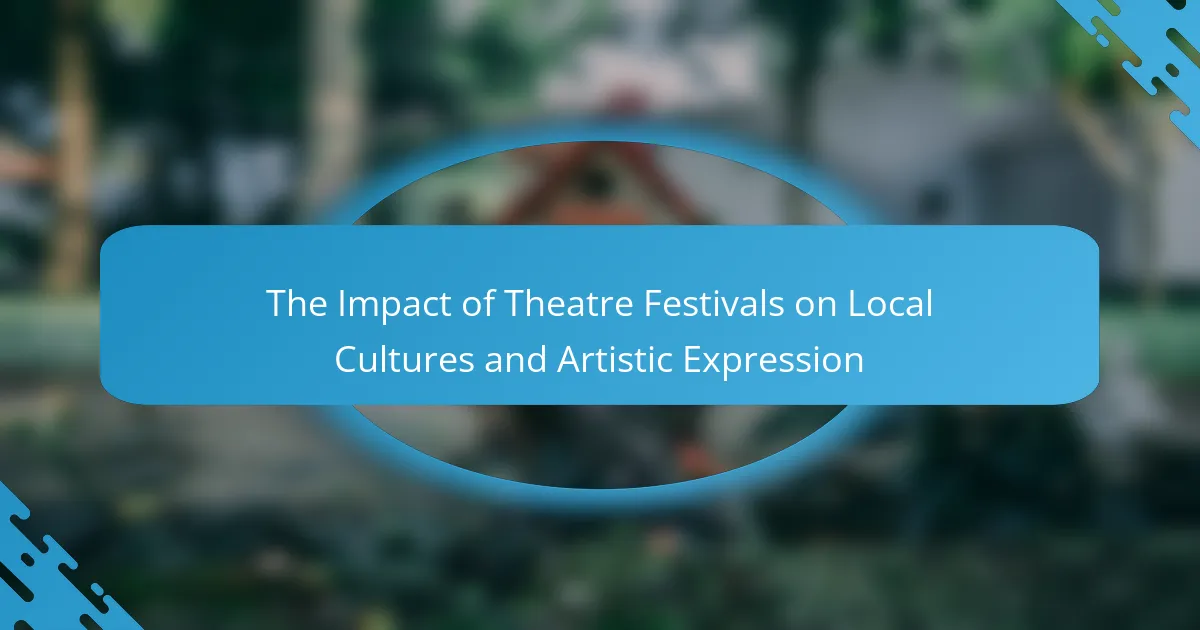Ancient Greek theatre is a foundational entity in the evolution of modern performance art, significantly shaping its structure and thematic depth. Key elements such as the three-act structure, character development, and the exploration of fate and morality are evident in contemporary storytelling. The use of masks and costumes in Greek theatre informs modern theatrical techniques, enhancing character portrayal and emotional expression. Additionally, the adaptation of the Greek chorus into ensemble performances and the continued relevance of social and political themes illustrate the enduring legacy of Ancient Greek theatre. This article examines these connections and provides insights into how modern performers can effectively integrate ancient techniques into their work.
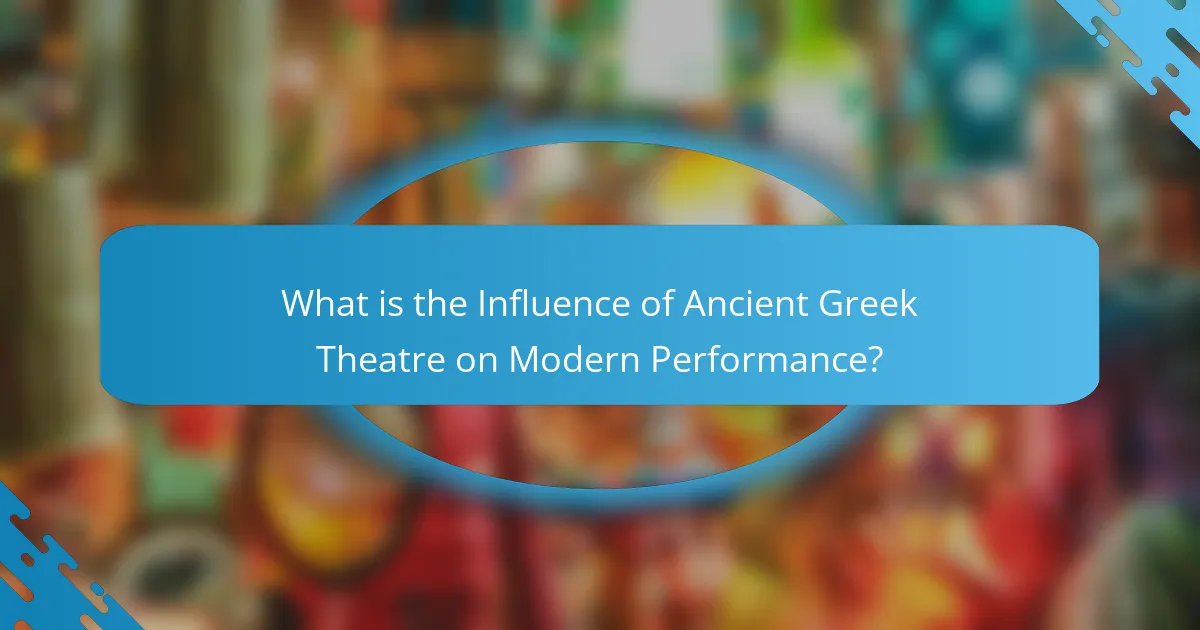
What is the Influence of Ancient Greek Theatre on Modern Performance?
Ancient Greek theatre significantly influences modern performance. It established foundational elements such as structured plays, character development, and thematic exploration. The use of masks and costumes in Greek theatre informs contemporary theatrical techniques. Greek tragedies and comedies introduced complex narratives that resonate in modern storytelling. The concept of catharsis, derived from Greek drama, remains relevant in today’s theatrical experiences. Additionally, the tradition of outdoor amphitheaters influences modern performance venues. The incorporation of chorus in Greek theatre parallels modern ensemble performances. Overall, the impact of Ancient Greek theatre is evident in various aspects of modern performance art.
How did Ancient Greek Theatre originate and evolve?
Ancient Greek Theatre originated in the 6th century BCE as part of religious festivals honoring Dionysus. These festivals included performances of dithyrambs, which were choral hymns. Over time, these performances evolved into more structured forms of drama. The introduction of an actor, Thespis, marked a significant shift from choral performances to dialogue. Aeschylus and Sophocles further developed the art form by adding more actors and complex narratives. By the 5th century BCE, theatre became a central cultural activity in Athens. The construction of the Theatre of Dionysus facilitated larger audiences and more elaborate productions. Ancient Greek Theatre laid the foundation for Western drama, influencing playwrights and performance styles for centuries.
What are the key characteristics of Ancient Greek Theatre?
Ancient Greek Theatre is characterized by its use of masks, outdoor venues, and a chorus. Masks allowed actors to portray different characters and express emotions. The theatres were typically built into hillsides to enhance acoustics and visibility. The chorus played a crucial role in narrating the story and commenting on the action. Performances were often based on mythology and explored themes of fate and morality. The structure of Greek plays typically included a prologue, episodes, and an exodus. These elements influenced the development of dramatic forms in Western theatre. The legacy of Ancient Greek Theatre continues to shape modern performance practices.
How did cultural and historical contexts shape Ancient Greek Theatre?
Cultural and historical contexts significantly shaped Ancient Greek Theatre. The theatre emerged during a time of political and social transformation in Athens. Festivals like Dionysia celebrated the god Dionysus and promoted civic identity. Playwrights like Aeschylus and Sophocles explored themes of morality and human experience, reflecting societal values. The use of masks and chorus in performances conveyed collective emotions and narratives. Historical events, such as the Peloponnesian War, influenced themes of tragedy and conflict. Additionally, the patronage of wealthy citizens supported the arts, highlighting the connection between theatre and social status. These elements collectively defined the structure and content of Ancient Greek Theatre.
What are the primary elements of Ancient Greek Theatre that impact modern performance?
The primary elements of Ancient Greek Theatre that impact modern performance include the use of masks, the structure of the amphitheater, and the incorporation of chorus. Masks allowed actors to portray multiple characters and convey emotions effectively. This practice influences modern theatrical techniques in character representation. The amphitheater’s design enhanced acoustics and visibility, shaping modern stage layouts for better audience engagement. The chorus provided narrative and commentary, a technique that continues to be adapted in contemporary performances. These elements collectively demonstrate the foundational influence of Ancient Greek Theatre on modern theatrical practices.
How do themes and narratives from Ancient Greek Theatre resonate today?
Themes and narratives from Ancient Greek Theatre resonate today through their exploration of human emotions and societal issues. The themes of tragedy, fate, and morality remain relevant in contemporary storytelling. Modern plays and films often draw from Greek tragedies to depict complex characters facing moral dilemmas. The narrative structure of conflict and resolution found in Greek plays influences current dramatic writing. Additionally, the exploration of hubris and its consequences is a recurring theme in modern narratives. Studies show that audiences connect with these timeless themes, as they reflect enduring human experiences. The use of catharsis in storytelling, a concept rooted in Greek Theatre, continues to engage audiences emotionally. Overall, the impact of Ancient Greek Theatre is evident in the thematic depth and narrative techniques employed in today’s performances.
What role did performance styles and techniques play in shaping modern theatre?
Performance styles and techniques significantly shaped modern theatre by introducing diverse methods of expression. Ancient Greek theatre emphasized the use of masks, which allowed actors to portray multiple characters. This technique influenced modern actors to explore character transformation and emotional depth. Additionally, the incorporation of chorus in Greek plays provided a narrative device that modern theatre still utilizes for commentary and emotional resonance. The use of physicality in performance, rooted in Greek traditions, encourages contemporary performers to engage in movement and gesture as vital storytelling elements. Furthermore, the focus on dialogue and rhetoric in Greek theatre laid the groundwork for modern scriptwriting and performance styles. These elements collectively contribute to the ongoing evolution of theatrical expression, demonstrating the lasting impact of ancient techniques on contemporary practices.
Why is the study of Ancient Greek Theatre important for contemporary performers?
The study of Ancient Greek Theatre is important for contemporary performers because it provides foundational principles of drama and performance. Ancient Greek Theatre introduced essential elements like tragedy, comedy, and the use of masks. These elements continue to influence modern storytelling techniques. The structure of Greek plays, including the three unities of time, place, and action, informs contemporary scriptwriting. Furthermore, the themes explored in Greek Theatre, such as fate, morality, and human emotion, remain relevant today. Understanding these themes helps performers connect with audiences on a deeper level. Additionally, the physicality and vocal techniques used in Ancient Greek Theatre enhance a performer’s skill set. The traditions of chorus and audience interaction also enrich modern theatrical experiences.
How can modern actors and directors learn from Ancient Greek practices?
Modern actors and directors can learn from Ancient Greek practices by studying their emphasis on storytelling and character development. Greek theatre prioritized the narrative structure and the emotional journey of characters. This focus can enhance modern performances by encouraging deeper engagement with the script.
Additionally, the use of masks in Greek theatre taught actors about the physicality of performance. Masks allowed for exaggerated expressions, which can inform modern techniques in conveying emotions non-verbally.
Moreover, the communal aspect of Greek theatre fostered a strong connection between performers and the audience. This connection can inspire modern actors and directors to create immersive experiences that resonate with viewers.
Overall, integrating these ancient practices can enrich contemporary storytelling and performance techniques.
What insights can be gained from the audience’s role in Ancient Greek Theatre?
The audience’s role in Ancient Greek Theatre reveals insights into community engagement and cultural values. Audiences were integral to performances, influencing the emotional tone and reception of the plays. Their reactions, such as laughter or applause, shaped the actors’ performances. The amphitheater design facilitated a communal experience, emphasizing collective participation. Additionally, audience demographics reflected societal hierarchies, as seating was often arranged by social status. This structure highlights the interplay between class and culture in ancient times. The audience’s engagement also informed playwrights, guiding them in crafting narratives that resonated with public sentiment. Overall, the audience’s role was crucial in both shaping the theatrical experience and reflecting societal norms.
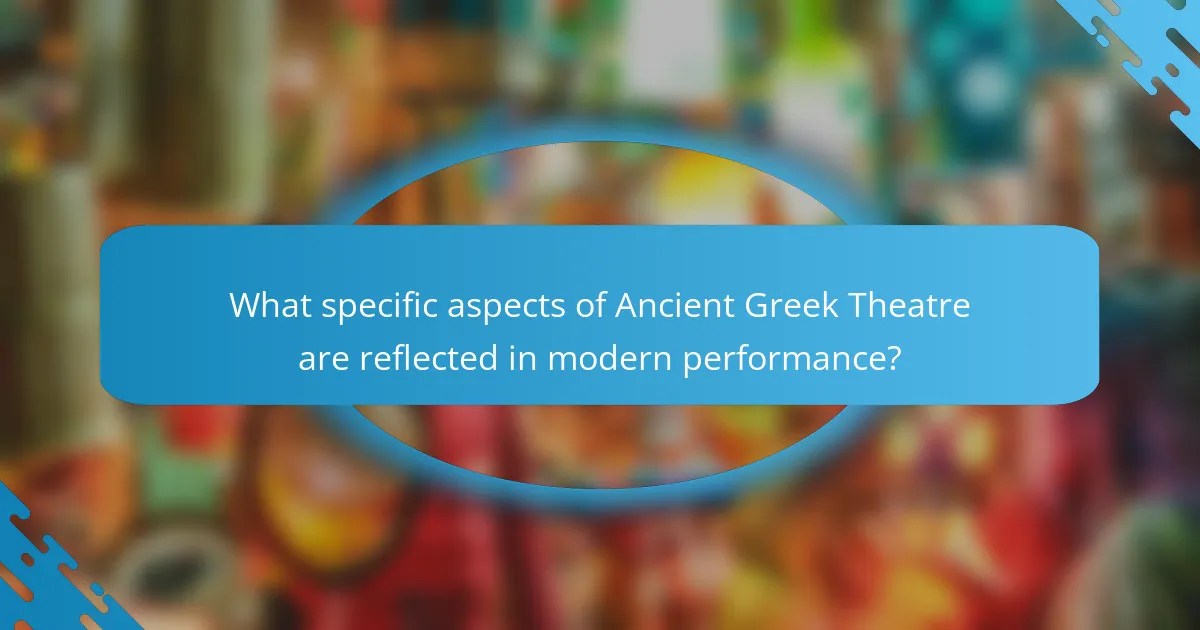
What specific aspects of Ancient Greek Theatre are reflected in modern performance?
Ancient Greek Theatre has significantly influenced modern performance through various aspects. The use of dramatic structure is one key element. Modern plays often follow a three-act structure, similar to ancient tragedies. Additionally, themes of fate, morality, and human experience, prevalent in Greek works, resonate in contemporary storytelling.
The role of the chorus is another reflection. While not always present, modern performances sometimes incorporate ensemble groups to enhance narrative. Furthermore, the use of masks in Ancient Greek Theatre has evolved into modern theatrical techniques that utilize makeup and costume design to convey character emotions.
The emphasis on dialogue and monologues in Greek plays is mirrored in modern scripts, showcasing character development and conflict. Finally, the exploration of social and political issues in Greek Theatre continues in modern performances, addressing contemporary societal themes. These connections illustrate the enduring legacy of Ancient Greek Theatre in shaping modern performance.
How do the structures of Ancient Greek plays influence current theatrical forms?
The structures of Ancient Greek plays significantly influence current theatrical forms. Ancient Greek theatre introduced key elements such as dialogue, character development, and dramatic structure. These elements laid the groundwork for modern storytelling techniques in theatre. The use of a three-act structure is a direct descendant of Greek tragedies and comedies. Additionally, Greek plays emphasized themes of morality and human experience, which remain central in contemporary works. The concept of the chorus in Greek theatre also persists in modern musicals and ensemble pieces. Furthermore, the exploration of complex characters and emotional depth in Greek plays is reflected in today’s character-driven narratives. Overall, the foundational aspects of Ancient Greek theatre continue to shape the framework of modern performance.
What are the similarities between Ancient Greek and modern playwriting techniques?
Ancient Greek and modern playwriting techniques share several similarities. Both utilize structured narratives that include a beginning, middle, and end. Conflict is central to both forms, driving the plot and character development. Dialogue serves as a primary tool for character expression and advancing the story in both styles. Themes of morality, identity, and human experience are explored similarly in both ancient and contemporary works. Additionally, the use of dramatic irony is prevalent in both, engaging audiences through tension between knowledge and ignorance. Lastly, both forms often incorporate elements of spectacle, such as staging and visual effects, to enhance the audience’s experience.
How is the use of masks and costumes in Ancient Greek Theatre mirrored today?
The use of masks and costumes in Ancient Greek Theatre is mirrored today in various theatrical performances. Modern theatre often employs masks to convey character emotions and enhance storytelling. Costumes continue to play a vital role in establishing character identities and setting the scene. The practice of using exaggerated features in masks is reflected in modern theatrical makeup techniques. Additionally, many contemporary productions utilize historical themes that echo the stylized aesthetics of Ancient Greek Theatre. The influence of Greek theatrical conventions can also be seen in the use of symbolic costumes to represent broader themes. Overall, the foundational principles of masks and costumes from Ancient Greece remain evident in today’s theatrical practices.
In what ways does the philosophy of Ancient Greek Theatre inform modern performance art?
The philosophy of Ancient Greek Theatre informs modern performance art through themes, structure, and audience engagement. Ancient Greek Theatre emphasized the exploration of human experience and emotion. This focus is evident in contemporary works that delve into similar themes of identity, conflict, and morality.
Additionally, the structure of Greek plays, including the use of prologue, episodes, and exodus, influences modern narrative techniques. Many modern performances employ similar structures to enhance storytelling.
Audience engagement was crucial in Ancient Greek Theatre, where spectators were active participants in the experience. This principle is mirrored in modern performance art, which often seeks to provoke thought and encourage interaction.
Moreover, the use of masks and exaggerated expressions in Greek Theatre informs the visual aesthetics of contemporary performance. This can be seen in various forms of theater and performance art that utilize physicality to convey emotion.
In summary, the philosophical foundations of Ancient Greek Theatre shape modern performance art through thematic exploration, structural influence, audience interaction, and visual representation.
How do concepts of tragedy and comedy from Ancient Greece manifest in today’s works?
The concepts of tragedy and comedy from Ancient Greece manifest in today’s works through themes, character archetypes, and narrative structures. Modern plays and films often explore tragic themes such as fate, suffering, and moral dilemmas, similar to Greek tragedies like those by Sophocles and Euripides. For instance, contemporary dramas often depict characters facing insurmountable challenges, reflecting the tragic hero’s journey.
In comedy, modern works utilize humor and satire to address societal issues, akin to the comedic plays of Aristophanes. Character archetypes such as the flawed hero or the cunning trickster are prevalent in both ancient and modern narratives. Additionally, the structure of acts and scenes in today’s theatre often mirrors the classical format established by Greek playwrights.
The influence is evident in popular media, including television series and films that draw on these ancient themes and structures. For example, the tragic elements in shows like “Breaking Bad” resonate with the moral complexities found in Greek tragedies. Similarly, comedic elements in series like “The Office” reflect the satirical nature of ancient comedies. This continuity illustrates the enduring relevance of Greek theatrical concepts in contemporary storytelling.
What lessons can be learned from Ancient Greek Theatre regarding audience engagement?
Ancient Greek Theatre teaches valuable lessons about audience engagement. Firstly, the use of compelling storytelling captivated audiences. The narratives often involved universal themes, such as fate and morality, which resonated with viewers. Secondly, the incorporation of music and dance enhanced emotional connection. These elements created a multisensory experience that drew audiences in. Thirdly, the physicality of performances emphasized expressions and emotions. Actors used exaggerated gestures to convey feelings, ensuring audience comprehension. Fourthly, the interactive nature of performances encouraged audience participation. Spectators often responded vocally, creating a shared experience. Lastly, the strategic placement of seating facilitated visibility and acoustics. This design ensured that all audience members felt included in the performance. Overall, these aspects of Ancient Greek Theatre highlight the importance of storytelling, sensory engagement, and audience interaction in creating memorable performances.
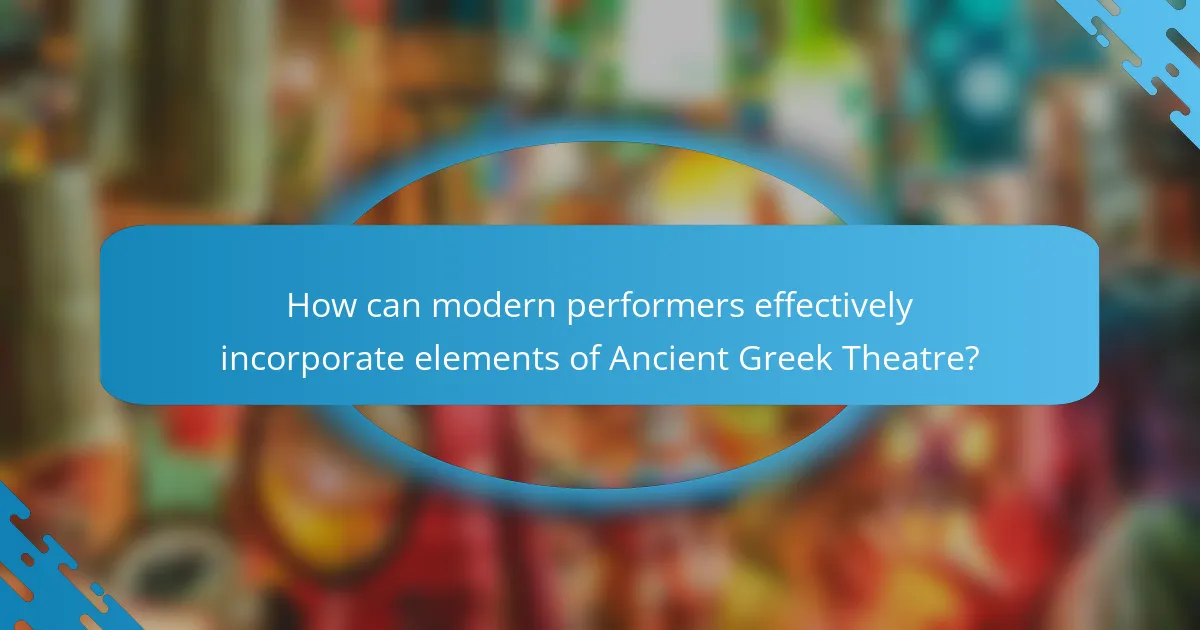
How can modern performers effectively incorporate elements of Ancient Greek Theatre?
Modern performers can effectively incorporate elements of Ancient Greek Theatre by utilizing its foundational techniques. These techniques include the use of masks, which enhance character portrayal and emotional expression. The Greek chorus can also be adapted to provide commentary and enhance narrative depth.
Additionally, performers can employ heightened language and poetic dialogue, reflecting the original works of playwrights like Sophocles and Euripides. Staging techniques, such as minimalistic sets and the use of outdoor spaces, can create an immersive experience.
Furthermore, integrating themes of fate, morality, and the human condition can resonate with contemporary audiences. Research shows that these elements foster a connection between ancient and modern storytelling. By blending these approaches, performers can create a unique theatrical experience that honors Greek traditions while appealing to today’s viewers.
What practical methods can be used to integrate Ancient Greek techniques into modern performances?
Practical methods to integrate Ancient Greek techniques into modern performances include the use of masks, chorus, and physicality. Masks can enhance character portrayal and provide a visual representation of emotions. The chorus can serve as a narrative device, offering commentary and context to the story. Physicality, including stylized movements and gestures, can evoke the heightened emotions seen in Greek theatre.
Additionally, incorporating themes of fate, morality, and the human condition aligns modern narratives with those of Ancient Greek plays. Utilizing outdoor spaces for performances mirrors the original amphitheaters, enhancing audience engagement. Training actors in the vocal techniques and rhythms of Greek drama can also deepen the authenticity of modern adaptations.
These methods draw directly from the historical practices of Ancient Greek theatre, ensuring a rich connection to its roots.
How can workshops and training focus on Ancient Greek Theatre principles?
Workshops and training can focus on Ancient Greek Theatre principles by incorporating techniques such as chorus work, improvisation, and physicality. These techniques reflect the essential elements of Greek performance. Workshops can emphasize the use of masks to explore character and emotion. Training can also include the study of Greek texts to understand themes and structures. Participants can engage in exercises that replicate the communal experience of ancient performances. Historical context can be provided to enhance understanding of the cultural significance. Additionally, practical applications can be explored through scene work and vocal training. This approach ensures a comprehensive understanding of Ancient Greek Theatre principles.
What are some successful examples of modern performances that draw from Ancient Greek Theatre?
Successful examples of modern performances that draw from Ancient Greek Theatre include “The Bacchae” by Robert Wilson and “Antigone” by Sophocles, adapted by Anne Carson. “The Bacchae” features innovative staging and contemporary themes while retaining the original’s emotional intensity. Anne Carson’s “Antigone” emphasizes modern existential dilemmas through a minimalist approach. Another notable example is “Oedipus Rex” by Robert Wilson, which combines visual art and theatre to explore fate and identity. These adaptations highlight the timeless relevance of Greek tragedies in addressing human experiences, showcasing their influence on modern performance.
What best practices should modern performers consider when exploring Ancient Greek Theatre?
Modern performers should prioritize understanding the historical context of Ancient Greek Theatre. This includes studying the cultural, social, and political influences of the time. Familiarity with key playwrights, such as Aeschylus, Sophocles, and Euripides, is essential. Performers should also explore the distinctive elements of Greek tragedy and comedy, including themes, structure, and character archetypes.
Engaging with the original texts is crucial. Reading and analyzing the plays in their original language can provide deeper insights. Additionally, performers should consider the significance of the chorus, as it plays a vital role in conveying themes and emotions.
Physicality and vocal techniques from Ancient Greek performance should be practiced. This includes using exaggerated gestures and clear vocal projection to enhance storytelling. Understanding the use of masks and costumes can also inform modern interpretations.
Lastly, participating in workshops or collaborating with experts in classical theatre can enrich a performer’s approach. This immersive experience fosters a more authentic connection to the material.
How can performers balance traditional techniques with contemporary storytelling?
Performers can balance traditional techniques with contemporary storytelling by integrating classical methods into modern narratives. They can utilize physicality and vocal techniques from ancient practices. This enhances expressiveness and emotional depth in performances. Contemporary themes can be woven into traditional structures, creating a dialogue between the past and present. For example, adaptations of Greek tragedies often explore modern societal issues. This approach maintains the integrity of traditional storytelling while making it relevant. Research shows that such fusions can engage diverse audiences effectively. This blending of styles enriches the performance experience and honors historical roots.
What resources are available for studying the influence of Ancient Greek Theatre on modern performance?
Key resources for studying the influence of Ancient Greek Theatre on modern performance include academic books, journal articles, and online databases. Notable books include “The Cambridge Companion to Greek Tragedy” edited by P.E. Easterling. This book provides insights into ancient practices and their modern interpretations. The journal “Classical Philology” features articles that explore the connections between ancient and contemporary theatre. Online databases like JSTOR and Project MUSE offer access to scholarly papers on the subject. Additionally, theatre companies often publish insights on their adaptations of Greek plays. These resources collectively support a comprehensive understanding of the topic.
The main entity of the article is Ancient Greek Theatre and its influence on modern performance. The article explores the foundational elements established by Ancient Greek Theatre, such as structured plays, character development, and thematic exploration, which continue to resonate in contemporary theatrical practices. Key characteristics, including the use of masks, chorus, and outdoor amphitheaters, are discussed alongside their impact on modern performance styles and techniques. Additionally, the article examines the cultural and historical contexts that shaped Ancient Greek Theatre and highlights the relevance of its themes and narratives in today’s storytelling. Overall, the article provides a comprehensive overview of how Ancient Greek Theatre has shaped the evolution of modern performance art.
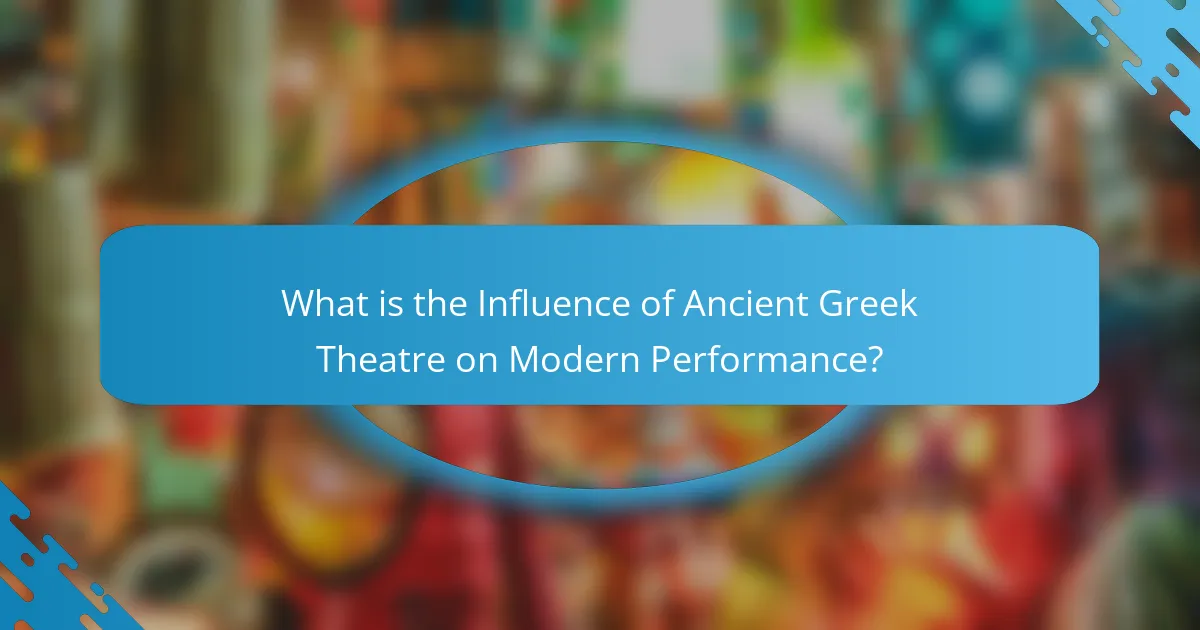
What is the Influence of Ancient Greek Theatre on Modern Performance?
Ancient Greek theatre significantly influences modern performance. It established foundational elements such as structured plays, character development, and thematic exploration. The use of masks and costumes in Greek theatre informs contemporary theatrical techniques. Greek tragedies and comedies introduced complex narratives that resonate in modern storytelling. The concept of catharsis, derived from Greek drama, remains relevant in today’s theatrical experiences. Additionally, the tradition of outdoor amphitheaters influences modern performance venues. The incorporation of chorus in Greek theatre parallels modern ensemble performances. Overall, the impact of Ancient Greek theatre is evident in various aspects of modern performance art.
How did Ancient Greek Theatre originate and evolve?
Ancient Greek Theatre originated in the 6th century BCE as part of religious festivals honoring Dionysus. These festivals included performances of dithyrambs, which were choral hymns. Over time, these performances evolved into more structured forms of drama. The introduction of an actor, Thespis, marked a significant shift from choral performances to dialogue. Aeschylus and Sophocles further developed the art form by adding more actors and complex narratives. By the 5th century BCE, theatre became a central cultural activity in Athens. The construction of the Theatre of Dionysus facilitated larger audiences and more elaborate productions. Ancient Greek Theatre laid the foundation for Western drama, influencing playwrights and performance styles for centuries.
What are the key characteristics of Ancient Greek Theatre?
Ancient Greek Theatre is characterized by its use of masks, outdoor venues, and a chorus. Masks allowed actors to portray different characters and express emotions. The theatres were typically built into hillsides to enhance acoustics and visibility. The chorus played a crucial role in narrating the story and commenting on the action. Performances were often based on mythology and explored themes of fate and morality. The structure of Greek plays typically included a prologue, episodes, and an exodus. These elements influenced the development of dramatic forms in Western theatre. The legacy of Ancient Greek Theatre continues to shape modern performance practices.
How did cultural and historical contexts shape Ancient Greek Theatre?
Cultural and historical contexts significantly shaped Ancient Greek Theatre. The theatre emerged during a time of political and social transformation in Athens. Festivals like Dionysia celebrated the god Dionysus and promoted civic identity. Playwrights like Aeschylus and Sophocles explored themes of morality and human experience, reflecting societal values. The use of masks and chorus in performances conveyed collective emotions and narratives. Historical events, such as the Peloponnesian War, influenced themes of tragedy and conflict. Additionally, the patronage of wealthy citizens supported the arts, highlighting the connection between theatre and social status. These elements collectively defined the structure and content of Ancient Greek Theatre.
What are the primary elements of Ancient Greek Theatre that impact modern performance?
The primary elements of Ancient Greek Theatre that impact modern performance include the use of masks, the structure of the amphitheater, and the incorporation of chorus. Masks allowed actors to portray multiple characters and convey emotions effectively. This practice influences modern theatrical techniques in character representation. The amphitheater’s design enhanced acoustics and visibility, shaping modern stage layouts for better audience engagement. The chorus provided narrative and commentary, a technique that continues to be adapted in contemporary performances. These elements collectively demonstrate the foundational influence of Ancient Greek Theatre on modern theatrical practices.
How do themes and narratives from Ancient Greek Theatre resonate today?
Themes and narratives from Ancient Greek Theatre resonate today through their exploration of human emotions and societal issues. The themes of tragedy, fate, and morality remain relevant in contemporary storytelling. Modern plays and films often draw from Greek tragedies to depict complex characters facing moral dilemmas. The narrative structure of conflict and resolution found in Greek plays influences current dramatic writing. Additionally, the exploration of hubris and its consequences is a recurring theme in modern narratives. Studies show that audiences connect with these timeless themes, as they reflect enduring human experiences. The use of catharsis in storytelling, a concept rooted in Greek Theatre, continues to engage audiences emotionally. Overall, the impact of Ancient Greek Theatre is evident in the thematic depth and narrative techniques employed in today’s performances.
What role did performance styles and techniques play in shaping modern theatre?
Performance styles and techniques significantly shaped modern theatre by introducing diverse methods of expression. Ancient Greek theatre emphasized the use of masks, which allowed actors to portray multiple characters. This technique influenced modern actors to explore character transformation and emotional depth. Additionally, the incorporation of chorus in Greek plays provided a narrative device that modern theatre still utilizes for commentary and emotional resonance. The use of physicality in performance, rooted in Greek traditions, encourages contemporary performers to engage in movement and gesture as vital storytelling elements. Furthermore, the focus on dialogue and rhetoric in Greek theatre laid the groundwork for modern scriptwriting and performance styles. These elements collectively contribute to the ongoing evolution of theatrical expression, demonstrating the lasting impact of ancient techniques on contemporary practices.
Why is the study of Ancient Greek Theatre important for contemporary performers?
The study of Ancient Greek Theatre is important for contemporary performers because it provides foundational principles of drama and performance. Ancient Greek Theatre introduced essential elements like tragedy, comedy, and the use of masks. These elements continue to influence modern storytelling techniques. The structure of Greek plays, including the three unities of time, place, and action, informs contemporary scriptwriting. Furthermore, the themes explored in Greek Theatre, such as fate, morality, and human emotion, remain relevant today. Understanding these themes helps performers connect with audiences on a deeper level. Additionally, the physicality and vocal techniques used in Ancient Greek Theatre enhance a performer’s skill set. The traditions of chorus and audience interaction also enrich modern theatrical experiences.
How can modern actors and directors learn from Ancient Greek practices?
Modern actors and directors can learn from Ancient Greek practices by studying their emphasis on storytelling and character development. Greek theatre prioritized the narrative structure and the emotional journey of characters. This focus can enhance modern performances by encouraging deeper engagement with the script.
Additionally, the use of masks in Greek theatre taught actors about the physicality of performance. Masks allowed for exaggerated expressions, which can inform modern techniques in conveying emotions non-verbally.
Moreover, the communal aspect of Greek theatre fostered a strong connection between performers and the audience. This connection can inspire modern actors and directors to create immersive experiences that resonate with viewers.
Overall, integrating these ancient practices can enrich contemporary storytelling and performance techniques.
What insights can be gained from the audience’s role in Ancient Greek Theatre?
The audience’s role in Ancient Greek Theatre reveals insights into community engagement and cultural values. Audiences were integral to performances, influencing the emotional tone and reception of the plays. Their reactions, such as laughter or applause, shaped the actors’ performances. The amphitheater design facilitated a communal experience, emphasizing collective participation. Additionally, audience demographics reflected societal hierarchies, as seating was often arranged by social status. This structure highlights the interplay between class and culture in ancient times. The audience’s engagement also informed playwrights, guiding them in crafting narratives that resonated with public sentiment. Overall, the audience’s role was crucial in both shaping the theatrical experience and reflecting societal norms.
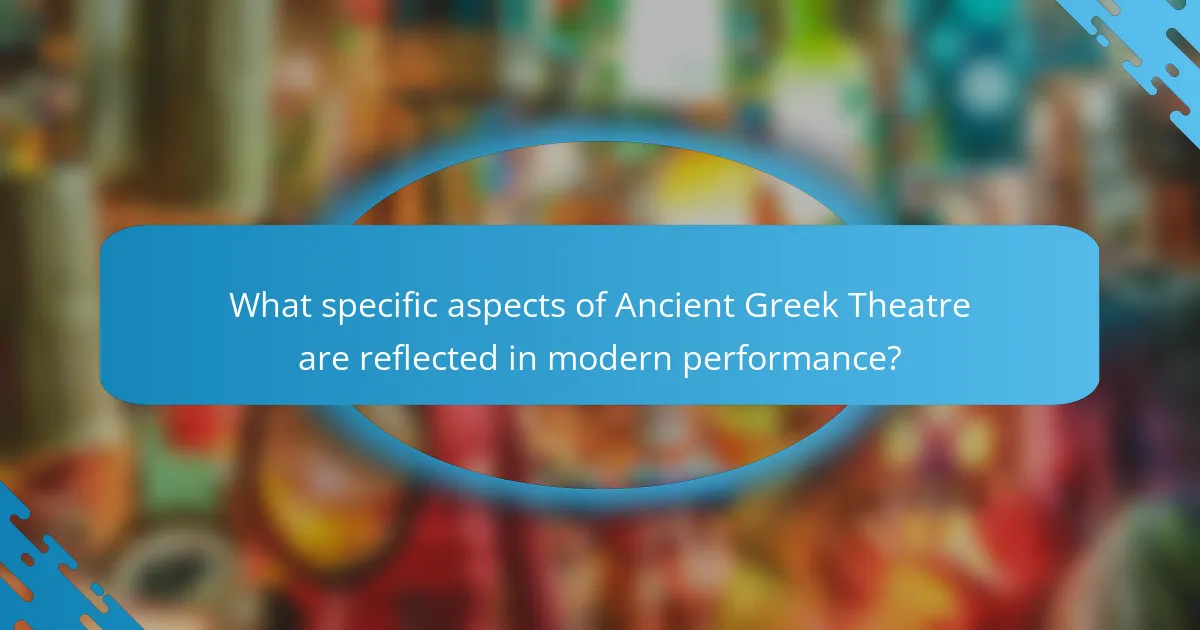
What specific aspects of Ancient Greek Theatre are reflected in modern performance?
Ancient Greek Theatre has significantly influenced modern performance through various aspects. The use of dramatic structure is one key element. Modern plays often follow a three-act structure, similar to ancient tragedies. Additionally, themes of fate, morality, and human experience, prevalent in Greek works, resonate in contemporary storytelling.
The role of the chorus is another reflection. While not always present, modern performances sometimes incorporate ensemble groups to enhance narrative. Furthermore, the use of masks in Ancient Greek Theatre has evolved into modern theatrical techniques that utilize makeup and costume design to convey character emotions.
The emphasis on dialogue and monologues in Greek plays is mirrored in modern scripts, showcasing character development and conflict. Finally, the exploration of social and political issues in Greek Theatre continues in modern performances, addressing contemporary societal themes. These connections illustrate the enduring legacy of Ancient Greek Theatre in shaping modern performance.
How do the structures of Ancient Greek plays influence current theatrical forms?
The structures of Ancient Greek plays significantly influence current theatrical forms. Ancient Greek theatre introduced key elements such as dialogue, character development, and dramatic structure. These elements laid the groundwork for modern storytelling techniques in theatre. The use of a three-act structure is a direct descendant of Greek tragedies and comedies. Additionally, Greek plays emphasized themes of morality and human experience, which remain central in contemporary works. The concept of the chorus in Greek theatre also persists in modern musicals and ensemble pieces. Furthermore, the exploration of complex characters and emotional depth in Greek plays is reflected in today’s character-driven narratives. Overall, the foundational aspects of Ancient Greek theatre continue to shape the framework of modern performance.
What are the similarities between Ancient Greek and modern playwriting techniques?
Ancient Greek and modern playwriting techniques share several similarities. Both utilize structured narratives that include a beginning, middle, and end. Conflict is central to both forms, driving the plot and character development. Dialogue serves as a primary tool for character expression and advancing the story in both styles. Themes of morality, identity, and human experience are explored similarly in both ancient and contemporary works. Additionally, the use of dramatic irony is prevalent in both, engaging audiences through tension between knowledge and ignorance. Lastly, both forms often incorporate elements of spectacle, such as staging and visual effects, to enhance the audience’s experience.
How is the use of masks and costumes in Ancient Greek Theatre mirrored today?
The use of masks and costumes in Ancient Greek Theatre is mirrored today in various theatrical performances. Modern theatre often employs masks to convey character emotions and enhance storytelling. Costumes continue to play a vital role in establishing character identities and setting the scene. The practice of using exaggerated features in masks is reflected in modern theatrical makeup techniques. Additionally, many contemporary productions utilize historical themes that echo the stylized aesthetics of Ancient Greek Theatre. The influence of Greek theatrical conventions can also be seen in the use of symbolic costumes to represent broader themes. Overall, the foundational principles of masks and costumes from Ancient Greece remain evident in today’s theatrical practices.
In what ways does the philosophy of Ancient Greek Theatre inform modern performance art?
The philosophy of Ancient Greek Theatre informs modern performance art through themes, structure, and audience engagement. Ancient Greek Theatre emphasized the exploration of human experience and emotion. This focus is evident in contemporary works that delve into similar themes of identity, conflict, and morality.
Additionally, the structure of Greek plays, including the use of prologue, episodes, and exodus, influences modern narrative techniques. Many modern performances employ similar structures to enhance storytelling.
Audience engagement was crucial in Ancient Greek Theatre, where spectators were active participants in the experience. This principle is mirrored in modern performance art, which often seeks to provoke thought and encourage interaction.
Moreover, the use of masks and exaggerated expressions in Greek Theatre informs the visual aesthetics of contemporary performance. This can be seen in various forms of theater and performance art that utilize physicality to convey emotion.
In summary, the philosophical foundations of Ancient Greek Theatre shape modern performance art through thematic exploration, structural influence, audience interaction, and visual representation.
How do concepts of tragedy and comedy from Ancient Greece manifest in today’s works?
The concepts of tragedy and comedy from Ancient Greece manifest in today’s works through themes, character archetypes, and narrative structures. Modern plays and films often explore tragic themes such as fate, suffering, and moral dilemmas, similar to Greek tragedies like those by Sophocles and Euripides. For instance, contemporary dramas often depict characters facing insurmountable challenges, reflecting the tragic hero’s journey.
In comedy, modern works utilize humor and satire to address societal issues, akin to the comedic plays of Aristophanes. Character archetypes such as the flawed hero or the cunning trickster are prevalent in both ancient and modern narratives. Additionally, the structure of acts and scenes in today’s theatre often mirrors the classical format established by Greek playwrights.
The influence is evident in popular media, including television series and films that draw on these ancient themes and structures. For example, the tragic elements in shows like “Breaking Bad” resonate with the moral complexities found in Greek tragedies. Similarly, comedic elements in series like “The Office” reflect the satirical nature of ancient comedies. This continuity illustrates the enduring relevance of Greek theatrical concepts in contemporary storytelling.
What lessons can be learned from Ancient Greek Theatre regarding audience engagement?
Ancient Greek Theatre teaches valuable lessons about audience engagement. Firstly, the use of compelling storytelling captivated audiences. The narratives often involved universal themes, such as fate and morality, which resonated with viewers. Secondly, the incorporation of music and dance enhanced emotional connection. These elements created a multisensory experience that drew audiences in. Thirdly, the physicality of performances emphasized expressions and emotions. Actors used exaggerated gestures to convey feelings, ensuring audience comprehension. Fourthly, the interactive nature of performances encouraged audience participation. Spectators often responded vocally, creating a shared experience. Lastly, the strategic placement of seating facilitated visibility and acoustics. This design ensured that all audience members felt included in the performance. Overall, these aspects of Ancient Greek Theatre highlight the importance of storytelling, sensory engagement, and audience interaction in creating memorable performances.
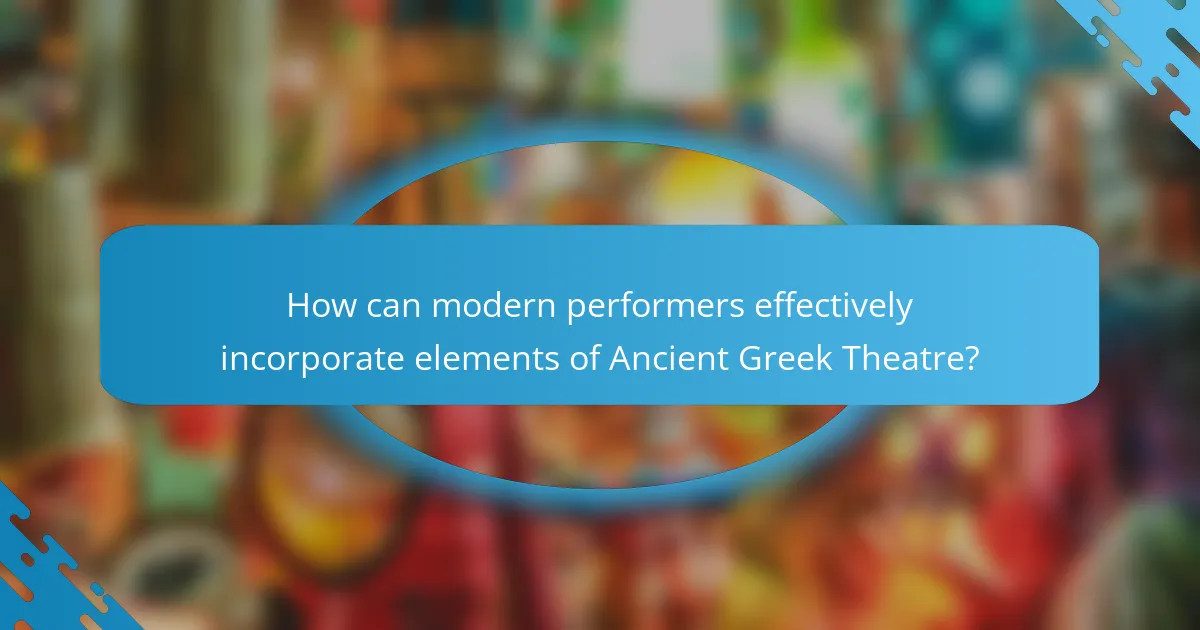
How can modern performers effectively incorporate elements of Ancient Greek Theatre?
Modern performers can effectively incorporate elements of Ancient Greek Theatre by utilizing its foundational techniques. These techniques include the use of masks, which enhance character portrayal and emotional expression. The Greek chorus can also be adapted to provide commentary and enhance narrative depth.
Additionally, performers can employ heightened language and poetic dialogue, reflecting the original works of playwrights like Sophocles and Euripides. Staging techniques, such as minimalistic sets and the use of outdoor spaces, can create an immersive experience.
Furthermore, integrating themes of fate, morality, and the human condition can resonate with contemporary audiences. Research shows that these elements foster a connection between ancient and modern storytelling. By blending these approaches, performers can create a unique theatrical experience that honors Greek traditions while appealing to today’s viewers.
What practical methods can be used to integrate Ancient Greek techniques into modern performances?
Practical methods to integrate Ancient Greek techniques into modern performances include the use of masks, chorus, and physicality. Masks can enhance character portrayal and provide a visual representation of emotions. The chorus can serve as a narrative device, offering commentary and context to the story. Physicality, including stylized movements and gestures, can evoke the heightened emotions seen in Greek theatre.
Additionally, incorporating themes of fate, morality, and the human condition aligns modern narratives with those of Ancient Greek plays. Utilizing outdoor spaces for performances mirrors the original amphitheaters, enhancing audience engagement. Training actors in the vocal techniques and rhythms of Greek drama can also deepen the authenticity of modern adaptations.
These methods draw directly from the historical practices of Ancient Greek theatre, ensuring a rich connection to its roots.
How can workshops and training focus on Ancient Greek Theatre principles?
Workshops and training can focus on Ancient Greek Theatre principles by incorporating techniques such as chorus work, improvisation, and physicality. These techniques reflect the essential elements of Greek performance. Workshops can emphasize the use of masks to explore character and emotion. Training can also include the study of Greek texts to understand themes and structures. Participants can engage in exercises that replicate the communal experience of ancient performances. Historical context can be provided to enhance understanding of the cultural significance. Additionally, practical applications can be explored through scene work and vocal training. This approach ensures a comprehensive understanding of Ancient Greek Theatre principles.
What are some successful examples of modern performances that draw from Ancient Greek Theatre?
Successful examples of modern performances that draw from Ancient Greek Theatre include “The Bacchae” by Robert Wilson and “Antigone” by Sophocles, adapted by Anne Carson. “The Bacchae” features innovative staging and contemporary themes while retaining the original’s emotional intensity. Anne Carson’s “Antigone” emphasizes modern existential dilemmas through a minimalist approach. Another notable example is “Oedipus Rex” by Robert Wilson, which combines visual art and theatre to explore fate and identity. These adaptations highlight the timeless relevance of Greek tragedies in addressing human experiences, showcasing their influence on modern performance.
What best practices should modern performers consider when exploring Ancient Greek Theatre?
Modern performers should prioritize understanding the historical context of Ancient Greek Theatre. This includes studying the cultural, social, and political influences of the time. Familiarity with key playwrights, such as Aeschylus, Sophocles, and Euripides, is essential. Performers should also explore the distinctive elements of Greek tragedy and comedy, including themes, structure, and character archetypes.
Engaging with the original texts is crucial. Reading and analyzing the plays in their original language can provide deeper insights. Additionally, performers should consider the significance of the chorus, as it plays a vital role in conveying themes and emotions.
Physicality and vocal techniques from Ancient Greek performance should be practiced. This includes using exaggerated gestures and clear vocal projection to enhance storytelling. Understanding the use of masks and costumes can also inform modern interpretations.
Lastly, participating in workshops or collaborating with experts in classical theatre can enrich a performer’s approach. This immersive experience fosters a more authentic connection to the material.
How can performers balance traditional techniques with contemporary storytelling?
Performers can balance traditional techniques with contemporary storytelling by integrating classical methods into modern narratives. They can utilize physicality and vocal techniques from ancient practices. This enhances expressiveness and emotional depth in performances. Contemporary themes can be woven into traditional structures, creating a dialogue between the past and present. For example, adaptations of Greek tragedies often explore modern societal issues. This approach maintains the integrity of traditional storytelling while making it relevant. Research shows that such fusions can engage diverse audiences effectively. This blending of styles enriches the performance experience and honors historical roots.
What resources are available for studying the influence of Ancient Greek Theatre on modern performance?
Key resources for studying the influence of Ancient Greek Theatre on modern performance include academic books, journal articles, and online databases. Notable books include “The Cambridge Companion to Greek Tragedy” edited by P.E. Easterling. This book provides insights into ancient practices and their modern interpretations. The journal “Classical Philology” features articles that explore the connections between ancient and contemporary theatre. Online databases like JSTOR and Project MUSE offer access to scholarly papers on the subject. Additionally, theatre companies often publish insights on their adaptations of Greek plays. These resources collectively support a comprehensive understanding of the topic.

